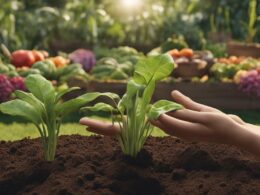Instead of tossing your grass clippings after mowing, there are several eco-friendly and beneficial ways to use them in your yard. From grasscycling to composting and mulching, you can transform your lawn waste into valuable resources for your garden. This article explores the different ways you can make the most of your grass clippings to benefit both your lawn and the environment.
When it comes to grass clippings, don’t let them go to waste. With these inventive and eco-friendly ideas, you can find new purpose for your mowings and create a healthier, more sustainable yard.
Grasscycling: Using Grass Clippings as Mulch
Grasscycling is the process of leaving your grass clippings on the lawn after mowing. Contrary to popular belief, grass clippings do not cause thatch buildup. Instead, they quickly decompose and provide several benefits to your lawn.
To be successful with grasscycling, it’s important to mow your lawn correctly. Stick to the recommended grass cutting height, mow when the grass is dry, and only cut with a sharp blade. These practices ensure that the clippings are the right size for easy decomposition and nutrient release.
When you grasscycle, the grass clippings act as a natural mulch. As they break down, they provide essential nutrients to the soil, reducing the need for fertilizers. This natural mulch also conserves water by retaining moisture in the soil and helps prevent weed growth by suppressing weed seeds.
Grasscycling offers numerous benefits for your lawn and the environment. Not only does it save you time and effort by eliminating the need to bag and dispose of clippings, but it also promotes a healthier and greener lawn. By recycling grass clippings as mulch, you can create a self-sustaining ecosystem in your yard.
However, it’s important to note that grasscycling is not recommended if your clippings are too long or if your lawn is affected by disease. In these cases, it’s best to collect and remove the clippings to prevent further issues.
Composting Grass Clippings
Another great use for grass clippings is to add them to your compost pile. Composting is an eco-friendly method of reducing landfill waste and promoting soil fertility. Grass clippings are a rich source of nitrogen, which helps heat up the compost pile and accelerate decomposition. It’s important to mix grass clippings with other dry yard waste, such as leaves or shredded paper, to avoid foul smells. Compost provides numerous benefits to the soil, including improved water and nutrient retention, aeration, and root penetration. However, it’s essential to avoid composting grass clippings that have been treated with herbicides or pesticides or if your lawn has diseases.
Composting grass clippings is a simple process that can yield rich, nutrient-dense compost for your garden. To start, create a compost pile in a designated area of your yard or use a compost bin if available. Layer the grass clippings with other compostable materials like leaves, kitchen scraps, or garden waste. Make sure to alternate between dry and wet materials to maintain the right moisture level in the compost pile. Turn the pile every few weeks to promote airflow and speed up decomposition.
Remember to avoid adding grass clippings that have been treated with herbicides or pesticides, as these chemicals can disrupt the natural microbial activity in the compost pile. Similarly, if your lawn has diseases, it’s best to dispose of the clippings separately to prevent the spread of pathogens.
By composting your grass clippings, you not only reduce waste going to landfills but also create a valuable resource for improving your soil’s health. The nutrient-rich compost can be used as a natural fertilizer, enriching the soil with essential elements and promoting the growth of healthy plants. Additionally, compost enhances the soil’s ability to retain moisture, reduces erosion, and helps suppress diseases and pests.
Using Grass Clippings as Mulch
Grass clippings are not just waste to be disposed of after mowing; they can also serve as an effective mulch for your garden beds. Mulching with grass clippings offers several benefits, including weed suppression, moisture conservation, regulation of soil temperature, and improvement of soil structure.
When using grass clippings as mulch, it’s important to apply a thin layer, approximately 1 to 2 inches thick, around flowers, vegetables, shrubs, and trees. This layer will help smother weeds, preventing them from receiving the sunlight they need to grow. It will also help retain moisture in the soil, reducing the need for frequent watering.
The mulch of grass clippings acts as a protective layer, shielding the soil from extreme temperatures and fluctuations. This can be particularly beneficial during hot summer months or cold winter periods, helping to maintain a more stable environment for the roots of your plants.
By utilizing grass clippings as mulch, you can also improve the structure of your soil over time. As the clippings break down, they contribute organic matter and nutrients to the soil, enhancing its fertility and overall health.
When using grass clippings as mulch, remember the following tips for optimal results:
- Use dry clippings: Wet clippings can lead to matting and water repellence. Allow the grass to dry out before using it as mulch.
- Avoid treated clippings: Do not use grass clippings that have been sprayed with herbicides or other lawn treatments. The chemicals in these products may harm your plants.
Now that you know the benefits and best practices for using grass clippings as mulch, you can make the most of this eco-friendly and cost-effective method to enhance your garden’s health and beauty.
Lasagna Gardening: Building Nutrient-Rich Soil
Lasagna gardening is an innovative technique that allows you to create nutrient-rich soil for your plants without the need for digging or tilling. This method involves layering organic materials like food scraps, paper, and other waste to create a fertile planting bed. And guess what? Grass clippings can be one of the key ingredients in this gardening method!
By using grass clippings for lasagna gardening, you can harness their valuable nitrogen content to enrich the soil and promote healthy plant growth.
Lasagna gardening works by creating layers of organic matter that decompose over time, creating a rich and workable soil. When you include grass clippings in these layers, you introduce a valuable source of nitrogen to the mix. Nitrogen is an essential nutrient that promotes lush foliage and vibrant growth in plants.
One of the major benefits of lasagna gardening is water conservation. The layers of organic matter act like a sponge, absorbing and retaining moisture, which reduces the need for frequent watering. This is especially beneficial during dry periods or in regions with water restrictions.
Another advantage of using grass clippings for lasagna gardening is weed control. The layering method suppresses weed growth by blocking sunlight and preventing weed seeds from germinating. This means less time spent pulling weeds and more time enjoying your beautiful garden.
Lasagna gardening also reduces the need for chemical fertilizers. The organic matter added to the layers breaks down over time, releasing nutrients into the soil. This natural fertilization process nourishes your plants and supports their overall health and vigor.
Remember to avoid using grass clippings that have been treated with herbicides or pesticides. Additionally, it’s best to steer clear of materials that may contain pests or diseases. By following these guidelines, you can ensure the success of your lasagna gardening project and create a thriving, eco-friendly garden.
When to Remove Grass Clippings
While leaving grass clippings on the lawn is generally recommended, there are some circumstances in which it may be necessary to remove them.
- If your lawn is heavily infested with diseases, it’s best to bag and remove the clippings to prevent further spread and damage.
- If the grass has become too tall and the clippings are clumping together, it’s advisable to remove them as they can smother the underlying grass and create an unsightly appearance.
- If you’ve recently treated your lawn with herbicides or insecticides, it’s important not to reuse the clippings in compost or as mulch. These chemicals may still be present on the clippings and can potentially harm your plants.
When deciding whether to remove grass clippings, consider your specific lawn conditions and make a judgment call based on what will be most beneficial for your lawn’s health and appearance.
How Can Self Propelled Lawn Mowers Help with Handling Grass Clippings?
Self propelled lawn mowers are a great help in handling grass clippings. With their built-in power, they can easily navigate through the lawn and collect clippings efficiently. Their advanced design and adjustable settings make it easier to manage and dispose of grass clippings, keeping the lawn neat and tidy.
Conclusion
In summary, grass clippings provide a multitude of benefits for your lawn and the environment. Whether you choose to grasscycle, compost, mulch, or use them in lasagna gardening, you can transform your lawn waste into valuable resources. By leaving your grass clippings on the lawn, you supply essential nutrients to the soil, reducing the need for chemical fertilizers and promoting healthier grass growth.
Additionally, using grass clippings as mulch helps conserve water, control weeds, and regulate soil temperature, leading to a more sustainable and attractive yard. Composting grass clippings not only reduces landfill waste but also enriches the soil with valuable nutrients, improving water and nutrient retention for your plants.
If you’re in search of a creative way to build nutrient-rich soil and control weeds, lasagna gardening with grass clippings is an excellent option. By layering grass clippings with other organic matter, you create a self-contained gardening system that promotes plant growth and requires minimal maintenance.
Remember to consider the specific conditions of your lawn and follow best practices when using grass clippings. Ensure that the clippings are free from disease or chemical treatments, and be mindful of the proper mowing techniques to maximize the benefits of grasscycling. By making informed choices, you can harness the full potential of grass clippings, contributing to a more sustainable and thriving outdoor space.










